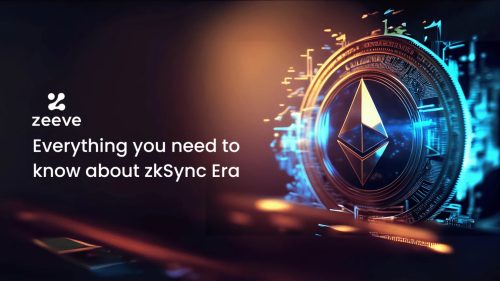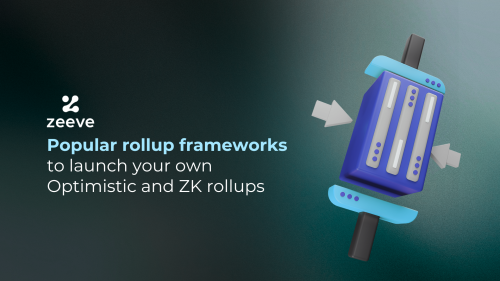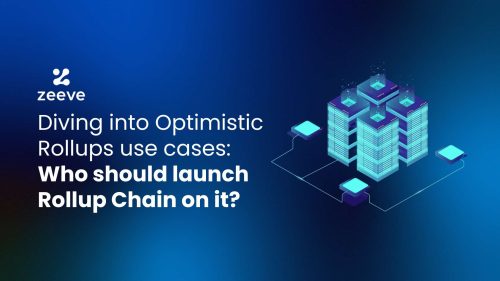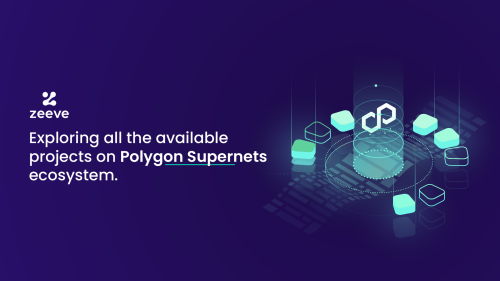
A comprehensive zkSync Era Guide: Everything you need to know
zkSync Era aims to solve one of blockchain’s biggest challenges— the scalability trilemma. As the leading smart contract blockchain, Ethereum has a rich-ecosystem of numerous Dapps and millions of daily transactions, which creates network congestion and low scalability. zkSync Era tackles the scalability issue on Ethereum via zk-rollup technology, which includes the computation of transactions off-chain while publishing validation proof on the Ethereum mainnet. Further, zkSync offers hyper scalability, top-notch security, and interoperability.
If you are planning to build your dApp with Zk-rollup technology, this zkSync Era guide provides a comprehensive insight into the zkSync era, its key features, working mechanisms, use cases, and more.
Let’s first understand what is zkSync Era
zkSync Era is an advanced Layer-2 scaling solution that utilizes zero-knowledge-based rollup technology to scale Ethereum. Rebranded from zkSync 2.0, zkSync Era is an iteration of zkSync 1.0, which is designed to be compatible with Ethereum’s technology, security, and its decentralized ethos, but there will be massive scalability and significantly lower fees through the implementation of zk rollups. zkSync Era computates transactions off-chain, and thereby stores most of the data off-chain. These transactions are then verified and a validity proof is submitted on the Ethereum mainnet so that the proof is stored safely and is available whenever required. This connectivity, allows zkSync Era to offer high security just like Ethereum on the Layer-2 rollup network.
zkSync Era mainnet is available for all the developers to deploy their dApps. Web3 projects and dApps can seamlessly migrate to the zkSync Era network, all their programming languages, wallets, tools, libraries, and other stack will remain the same. Projects can even build a Layer-3 zk–rollup on the top of zkSync era. With this option, zkSync Era offers a multi-layer rollup architecture while maintaining interoperability across all the chains. Having these functionalities, zkSync can power a range of use cases that require L1 to L2 functionality, such as custom bridges, multi-layer governing smart contracts, and other future-proof projects.
How zkSync Era exactly works?
zkSync Era divides the network’s operations into two components– the Rollup transactions and the priority transactions. Here, the roll transactions are initiated by a rollup account within rollup. Whereas, the priority transactions are initiated on Ethereum mainchain by an Ethereum-based account. This approach enables zkSync Era to offload considerable network load from the Layer-1 Ethereum, reducing the network congestion for a speeder operation.

The zkSync Era’s mainly requires assistance from an ‘Operator’ and the ‘Verifier. Following are the stages that quickly explains the operation mechanism of zkSync Era:
Stage1- Pending: User initiates transactions, which Operator receives but keeps it pending for processing.
Stage2- Processed: Operator processes the transaction and confirms its inclusion in the next block.
Stage3- Committed: This stage indicates that the data for the block’s transaction is published on Ethereum. This means that data availability is ensured, but final confirmation is pending.
Stage4- Finalized: This ensures that transactions have been duly validated by the Verifier and a corresponding SNARK validity proof is submitted on Ethereum.
The typical time taken to complete from Pending to Finalized is a couple of hours.
What makes zkSync Era a leading Layer-2 Rollup ecosystem?
zkSync Era offers a range of industry-leading features that support development of highly scalable, secure, and interoperable dApps. For this zkSync Era guide, let’s discuss some of the main features:
EVM-compatibility in a permissionless way:
zkSync Era maintains full compatibility with Ethereum in a permissionless way, hence allows dApps to permissionless smart contracts. As discussed, Era offers dApps with a smoother, non-complex, and extremely less resource-intensive transitions of their EVM-based dApps to zSync Era’s ecosystem. All they need to do is a just minimal modification to the underlying codebase while the original state remains preserved. Further, to deploy on zkSync, you do not need to learn a special smart contract or programming language. Era’s native support for universally-used languages like Solidity and Vyper enables great ease for Ethereum-based projects.
Massive scalability with Hyperscaling feature:
zkSync era is designed to offer massive scalability with an innovative concept of network called ‘Hyperchains’. These are similar to application-specific chains, but are zkEVM’s fractal-like instances running in parallel, and sharing a common settlement layer— Layer-1. By introducing Hyperchains, ZkSync era aims to onboard billions of users while providing them great user experience with higher TPS, as high as 2000 and other benefits like cross-Hyperchain interoperability, unified wallet management, and customization of the chain as per use-case specific needs.
Battle-tested security with zero reliance on third-parties:
By combining the on chain-data availability mechanism with leading-edge cryptography technology, zkSync era strands out remarkably in terms of enabling battle-tested security on Layer-2. Further, as a Ethereum-scaling solution, zkSync era is authorized to inherit 100% Ethereum’s security to offer mainnet-like security on its Layer-2 rollup ecosystem with no reliance on any 3rd party blockchain security services. With this unique approach to security, zkSync era envisions a multi-layered security system where there is no issues like single point of failure or delay in executing transactions, which can raise security concern for the whole ecosystem.
Support for Account Abstraction feature:
zkSync era claims to be the first zkEVM chain to offer native support for the Account Abstraction feature. With Account Abstraction, zkSync era allows the accounts to initiate transactions like externally-owned accounts (EOAs), but they can also implement arbitrary logic in their account just like how it is done on smart contracts. Basically, Account Abstraction enables accounts to customize wallet authorization, such as unique signature schemes, adding multi-sig capabilities, spending limits, and other use case-specific limitations. Also, the Account Abstraction feature unlocks a great benefit for dApps using zkSync era, which is the ease of paying gas fees in any token, not just ETH. Having all these features, Account Abstraction in the zkSync Era brings major improvements both for dApps and users interacting with the network.
Ability to preserve key features of EVM:
Although designed for scaling Ethereum, zkSync era is committed to preserving Ethereum’ key features, such as smart contract composability. This means, that web3 projects migrating to zkSync era do not have to spend time building their smart contract from scratch. Instead, they can leverage the composability features such as modularity, autonomy, and discoverability to use your smart contract from a separate project as building blocks for zkSync dApp.
Optimized for lower gas fee and instant finality:
Although zkSync Era’s ecosystem depends on underlying Layer-1 (Ethereum) for finality, it still offers instant transactions finality of a few seconds. As soon as transactions are submitted to the zkSync era, the process of L1 smart contract updating the L2 state starts, which may take up to 24 hours. Despite this, all the transaction details are displayed in the API and UI within a second. Plus, the transferred assets are then ready to make transfers across different chains.
Speaking about the gas fee, zkSync era offers an average gas fee of 0.00056ETH, through the network is constantly rolling up new technology to improve TPS and lower the gas fee.
Interoperability through bridges:
zkSync era offers interoperability between Layer-1, Layer-2 and Layer-3 through its native bridges; txSync and zkSync Lite. Plus, a range of supported bridges such as L2Scan Protocol, Layerswap, Rhino, etc. Further, web3 projects are free to build their own custom bridge with zkSync era to support their specific token.
Compatibility with Zkporter network:
One of the most significant upgrades on zkSync is zkPorter, which will be released soon. zkPorter uses an off-chain data availability mechanism to offer much higher security than the current 20,000+ TPS, and a 20x transaction fee reduction (possibly compared to Layer-1 Ethereum). ZkSync allows zkSync era to be interoperable with zkPorter, forming a dual-branch design for ultra-secure, ultra-fast, and significantly cheaper transactions.
List of current dApps on zkSync Era
zkSync era’s innovative Rollup technology and next-level scaling features encourage various web3 projects to build or migrate to zkSync. And, hence, zkSync era records a TVL of $112.27M and a total of 162 929 647. Since its mainnet launch, zkSync era has listed a total of 138 dApps on its ecosystem, which includes top DeFi projects like
PancakeSwap V3, 1inch Network, EraLend, Interport Finance, CelerNetwork, Holdstation DeFutures, OpenOcean, and more.
The gaming projects include Area of Faith, ArchLoot, Crypto Maze, Galaxia Studios, Legend Wanderer, Mechaverse, Petaverse, Robots Farm, SecondLive, Tevaera, Tiny World, and Wemix Play.
Wallets include FoxWallet, OKX Wallet, and WalletConnnect. Other dApp categories in zkSync era are bridges, DAOs, infrastructure, governance, Gateways, social apps, tools, and more.
Tools and resources for building on zkSync Era
To build a dApp on zkSync era, enterprises usually need a DevOps team with extensive Ethereum experience. Plus, developers must have familiarity with all the zkSync-based tools and stacks, including:
- SDKs: Javascript SDK, Python SDK, Golang SDK, Java SDK, Rust SDK.
- Frameworks, toolchains, and IDEs: zksync-cli, Atlas ZK, Foundry, Hardhat, Openzeppelin, Particle Network, and Thirdweb.
- For Testing and debugging: In-memory node and Docker setup.
- Infrastructure: Nodes– RPC nodes, full nodes, and validator nodes.
- Data indexers: Subgraph and Subquery.
- APIs and analytics- Chainbaser and Covalent..
- Oracles: Chainlink, standard web3 APIs, DIA, Pyth, Redstone, etc.
Deploy your zkSync Era dApps easily with Zeeve
As discussed throughout this zkSync era guide, this Zk-rollup is a game-changer for web3, but building your dApp on its ecosystem can be a bit of complex process, especially for projects that are just starting it.
Zeeve provides a solution from this. Zeeve makes deployment of your zkSync era dApps a lightning-fast and hassle-free process. You will get all the resources— be it scalable nodes, secure RPC endpoints, multi-cloud support, specialized DevOps & plug-n-play tools— making deployment lightning-fast and hassle-free. Plus, our DevOps team has familiarity with all the zkSync-supported tools, SDKs, and frameworks. Zeeve also offers continuous monitoring of cloud resources and logs to ensure optimal performance.
Also, Zeeve is ISO 27001 and SOC 2 Type 2 compliant and has enterprise-level SLA, which guarantees the reliability of our service.
For more details about our zkSync era services or simplified rollup implementation through zkRollups-as a-service, feel free to contact us. Drop us your queries via email on this page or schedule one-to-one calls with our blockchain experts.







Responses